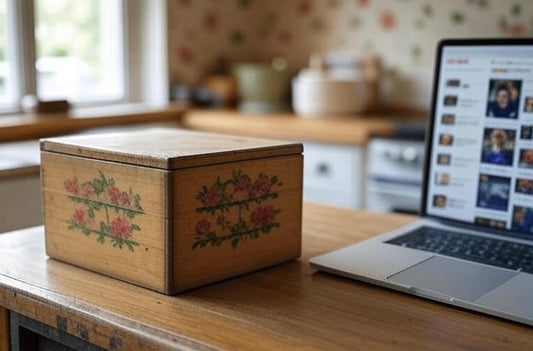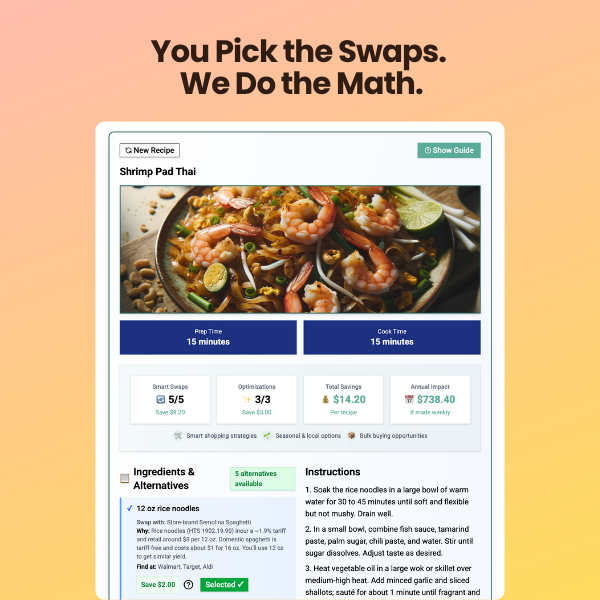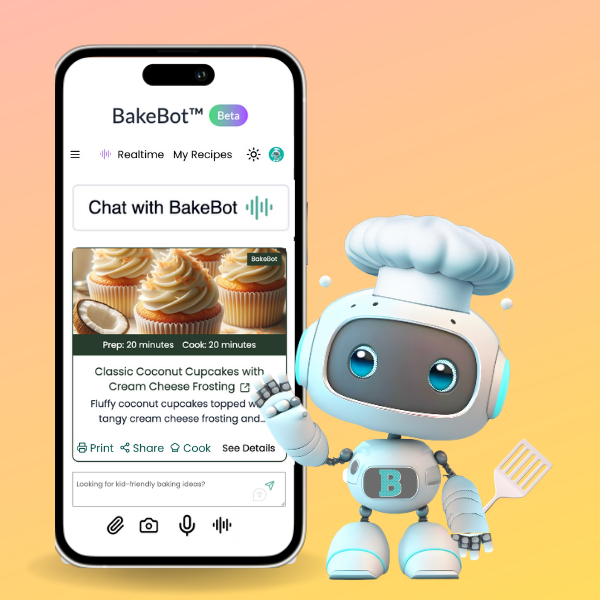
Pie Hard: Your No-Stress Guide to Perfect Thanksgiving Pies (with a Little Help from BakeBot)
Babette PepajThanksgiving is the Super Bowl of pie baking. Whether you’re a seasoned pro or this is your first attempt at a lattice crust that doesn’t look like a Pinterest fail, needing a little help is completely normal. Lucky for us, BakeSpace.com has just launched BakeBot, your new AI kitchen sidekick who can answer all your pie (and any cooking) questions.
From creating recipes to helping you modify your own, we hope BakeBot is your go to recipe help this holiday season. Best part? It can instantly store your recipes (even handwritten recipe cards) in your own free online kitchen at BakeSpace.com, so you never have to search for that recipe again. BakeBot works on all BakeSpace recipe pages too so if you need to make a modification, just ask! It can even save your modified recipe from our BakeBot chat too!
But first... The pie.
Here’s a breakdown of the top questions every home cook asks when it’s time to bake those perfect Thanksgiving pies. Ready? Let’s do this.
What’s the Secret to a Flaky Pie Crust?
The secret to flaky crust is cold everything—cold butter, cold water, cold hands if you need them. The colder your ingredients, the better those buttery layers will puff up in the oven. And don’t overwork the dough. Less is more when it comes to mixing, rolling, and handling.
BakeBot Wow Factor: Did you know that apple cider vinegar or vodka can be used in place of some water in your dough? These liquids help prevent gluten formation, which makes for a tender, flakier crust. The acidity of apple cider vinegar helps inhibit gluten formation, which makes the crust more tender. Similarly, vodka inhibits gluten development because it doesn't contribute water to the dough, which can make it easier to work with and result in a flakier texture.
As for the exact swap amounts, typically, you can replace 1 to 2 tablespoons of the water with an equal amount of apple cider vinegar or vodka. However, it’s always good to follow the specific recipe's recommendations or consult with BakeBot for precise measurements.
How Do I Prevent My Pie Crust from Getting Soggy?
No one wants a soggy bottom. To avoid this, you’ll need to blind bake the crust (pre-bake it before adding your filling). Lining your crust with parchment paper and using pie weights (or beans) will help keep its shape. Another trick? Brush the crust with egg white before adding your filling for a moisture barrier.
BakeBot Wow Factor: Use dried breadcrumbs or crushed nuts on the bottom of the crust before adding the filling. They’ll absorb any extra moisture and add a subtle layer of flavor. Just ask BakeBot for exact proportions!
What’s the Best Way to Make Pumpkin Pie from Scratch?
If you want to go all-in, making pumpkin pie from scratch starts with roasting a sugar pumpkin (or pie pumpkin). After roasting, puree the flesh and mix it with your classic ingredients like cinnamon, nutmeg, and ginger. For a smoother consistency, run the puree through a fine-mesh sieve.
BakeBot Wow Factor: Can’t decide between fresh and canned? Fresh pumpkin can vary in water content, while canned is more consistent. BakeBot can help you adjust your recipe based on whether you’re using fresh or canned, ensuring the perfect texture every time.
How Do I Make a Perfect Pecan Pie?
A perfect pecan pie is all about a gooey center and a crunchy top. Avoid overbaking, which can lead to a hard filling. Pull it out when it’s just set but still a little jiggly in the center—it will firm up as it cools.
BakeBot Wow Factor: For a flavor boost, toast your pecans before adding them to the filling. And for a deeper, richer taste, try adding a spoonful of molasses or dark rum to the filling. BakeBot can show you how much to add without overpowering the flavor!
Bonus tip: Corn Syrup Substitute - Many pecan pie recipes call for corn syrup, which helps achieve that classic gooey texture. If you want to avoid corn syrup, you can substitute with honey or maple syrup, but keep in mind that it will alter the flavor slightly.
What’s the Difference Between Using Fresh vs. Canned Pumpkin?
Let's see... Each option has its merits, so it really depends on your preference and the time you have available. 🎃🥧
Fresh Pumpkin:
- Flavor: Has a lighter, more delicate taste.
- Texture: Fresh pumpkin can have a slightly more fibrous texture.
- Preparation: Be sure to roast and puree it properly to achieve a smooth consistency. This extra step can be time-consuming, but it's rewarding.
Canned Pumpkin:
- Flavor: More concentrated and richer due to the cooking and canning process.
- Consistency: More reliable and consistent in texture and moisture content, which simplifies the baking process.
- Convenience: Ready to use right out of the can, making it a quicker option.
Additional Tips:
- Variety: Canned pumpkin often includes varieties like Dickinson squash, which contribute to its rich, sweet flavor. This variety is closer to butternut squash than to the typical carving pumpkins.
- Water Content: Fresh pumpkin can have more water, so you might need to strain the puree or adjust the amount of liquid in your recipe to avoid a runny pie filling.
- Taste Test: If you're unsure which one you prefer, try making two small pies—one with fresh pumpkin and one with canned—and compare the flavors and textures.
How Do I Prevent My Pie from Cracking?
Pies like pumpkin and pecan are prone to cracking if they’re overbaked. The key is to pull them out when the filling is still a little wobbly in the middle. It will set as it cools, and you’ll avoid that sad cracked top. Here are some additional tips:
- Avoid Drastic Temperature Changes: Sudden changes in temperature can cause the filling to crack. Try to cool your pie gradually.
- Eggs and Overmixing: Avoid overmixing your filling. Overmixing can incorporate too much air, which can cause cracks as the pie bakes.
- Cover the Crust Edges: Covering the edges of your crust with foil can help prevent the edges from burning while the center finishes setting.
BakeBot Wow Factor: Baking your pie in a water bath provides gentle, even heat, which helps prevent cracking. To do this, wrap the bottom of your pie dish in foil to prevent water from seeping in, place it in a larger baking dish, and fill the larger dish with hot water until it reaches halfway up the side of your pie dish.
How Can I Make Pie Ahead of Time and Store It Properly?
Yes, you can definitely make pies ahead of time! Most pies (pumpkin, pecan, apple) can be made a day or two in advance. This gives you one less thing to stress over on the big day. Here are a few additional tips to ensure your pies stay fresh and delicious:
- Cooling: Always let your pies cool completely before covering and refrigerating them. This helps prevent condensation, which can make the crust soggy.
- Covering: Wrap the pies tightly in plastic wrap or aluminum foil. For added protection, you can also place them in a large, airtight container.
- Refrigeration: Store your pies in the refrigerator to keep them fresh. Most pies will last 2-3 days when stored this way.
BakeBot Wow Factor: Sugar and Cornstarch Mix. Brushing your fruit pies with a mixture of sugar and cornstarch before storing can help keep them from turning soggy. The cornstarch acts as a moisture barrier, and the sugar adds a nice touch of sweetness.
Additional Tips:
- Freezing: If you need to make pies well in advance, consider freezing them. Pies like apple and pecan freeze well. Wrap them tightly and place them in a freezer-safe bag or container. Thaw in the fridge overnight before serving.
- Reheating: For that freshly baked taste, warm your pie in the oven at a low temperature (around 300°F or 150°C) for about 10-15 minutes before serving.
Can I Freeze Pies? If So, How Do I Reheat Them?
Yes, that’s true! Freezing pies 🥧❄️ is a fantastic way to prepare in advance. Here are the detailed steps and a few extra tips:
Freezing Pies:
- Bake the Pie: Fully bake your pie as you normally would.
- Cool Completely: Let the pie cool completely to room temperature. This helps prevent condensation, which can make the crust soggy.
- Wrap Tightly: Wrap the pie tightly in plastic wrap, then in aluminum foil to protect it from freezer burn. Alternatively, place it in a freezer-safe bag or container.
- Label and Freeze: Label the pie with the date and type, then place it in the freezer. Most pies can be frozen for up to 2-3 months.
Reheating Pies:
- Thaw in the Fridge: Move the frozen pie to the refrigerator and let it thaw overnight.
- Reheat in the Oven: Preheat your oven to 350°F (175°C). Unwrap the pie and place it on a baking sheet. Reheat for about 20-30 minutes, or until warmed through.
BakeBot Wow Factor:
- Freezing Pie Dough: Yes, you can freeze your pie dough ahead of time. Roll it out, place it between sheets of parchment paper, and freeze flat. This makes it easy to have dough ready for whenever you need it.
- Sliced Pies: You can also freeze individual slices of pie. This is perfect for having a single-serving treat whenever the craving hits.
- Adjusting Baking Time: If you're freezing an unbaked pie, you might need to add a few extra minutes to the baking time since it’s starting from a colder temperature.
How Do I Make a Lattice Pie Crust?
A lattice crust may look fancy, but it’s surprisingly easy once you get the hang of it. Roll out your dough, cut it into strips, and weave them over the top of your pie. The key? Chill the dough before cutting and weaving, so it’s easier to handle.
Here are the detailed steps and a few extra tips:
Making a Lattice Pie Crust:
- Roll Out the Dough: Roll out your dough into a large circle.
- Cut into Strips: Use a sharp knife or a pizza cutter to cut the dough into even strips, about 1/2 to 3/4 inch wide.
- Chill the Strips: Place the strips on a baking sheet lined with parchment paper and chill them in the refrigerator for about 10-15 minutes. This makes them easier to handle and less likely to tear.
- Weave the Lattice:
- Seal and Trim: Press the edges to seal the lattice strips to the bottom crust, then trim any excess dough.
- Chill Again: Place the pie in the refrigerator for another 10-15 minutes to ensure the dough stays firm.
BakeBot Wow Factor:
- Brushing with Sugar Syrup: For a shiny, caramelized finish, brush your lattice with a simple sugar syrup before baking. Mix equal parts sugar and water, and brush it over the lattice.
- Flavor Customization: Add a bit of vanilla extract, bourbon, or even a pinch of cinnamon to your sugar syrup for extra flavor.
Additional Tip:
- Egg Wash: Instead of sugar syrup, you can also brush the lattice with an egg wash (a beaten egg mixed with a tablespoon of water or milk) before baking to give it a golden, glossy finish.
Making a lattice crust can be fun and adds a beautiful touch to your pies.
What Are Some Fun Pie Variations (Mini Pies, Pie Bars, etc.)?
Feeling creative? Here are a few more fun pie variations you might enjoy:
- Mini Pies: These are perfect for individual servings and can be customized with different fillings. Use a muffin tin to bake these mini delights.
- Pie Bars: Great for serving a crowd, pie bars have all the deliciousness of a pie in a more portable form. Think of them as the pie’s answer to brownies.
- Hand Pies: Also known as pasties or turnovers, hand pies are small, portable pies filled with sweet or savory ingredients. They’re perfect for picnics or lunches on the go.
- Pie Pops: Tiny pies on a stick! These are not only adorable but also great for parties and kids' events. You can use a lollipop stick to create these bite-sized treats.
- Mason Jar Pies: Baking pies in mason jars is both charming and practical. They make lovely gifts and can be sealed and stored easily.
- Galettes: A rustic, free-form pie that doesn’t require a pie dish. You simply fold the edges of the dough over the filling.
- Slab Pies: Made in a rectangular baking sheet, slab pies are perfect for feeding a large group. They’re easier to cut into squares and serve.
BakeBot Wow Factor:
- Customizable Syrup: Brush your mini pies or hand pies with a sugar syrup infused with flavors like vanilla, bourbon, or even citrus zest before baking. This will add a beautiful shine and an extra layer of flavor.
- Creative Fillings: Experiment with unique fillings like salted caramel apple, chocolate hazelnut, or even savory options like spinach and feta.
This Thanksgiving (and every day of the year), BakeBot is your personal pie consultant—answering all your cooking questions, modifying your recipes, and even storing your favorites in your own online kitchen at BakeSpace.com. Happy pie-making!
Try BakeBot - https://bakespace.com/bakebot
Image made with TastyUpdate.com.










